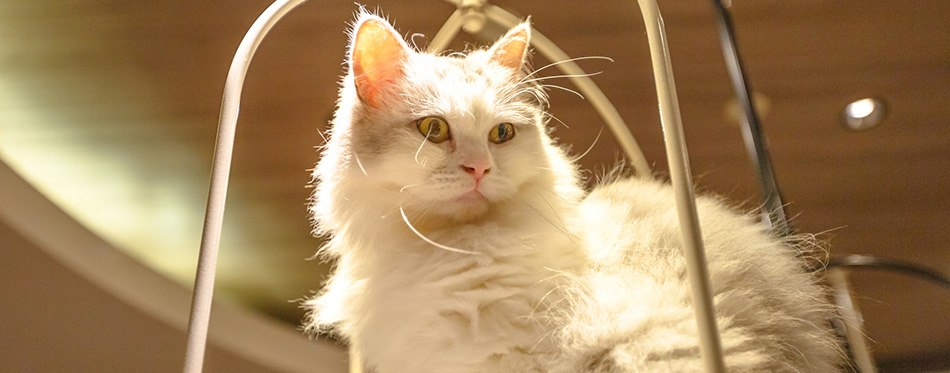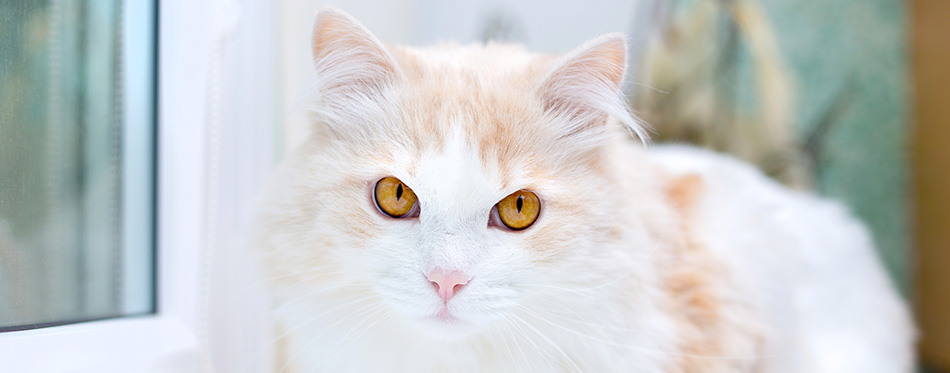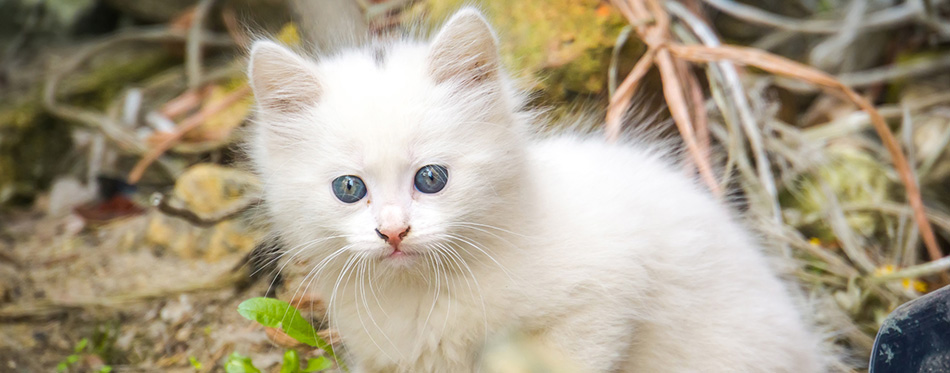If you want to adopt an intelligent, affectionate pet, a Turkish Angora could be the perfect companion for you. With its long, silky coat, and balanced body, these cats are also widely admired for their elegance and grace. Characterized by a tapered tail, shimmering hair, and large pointed ears, the Angora is certainly striking to behold.
As its name suggests, the Turkish Angora originates in Turkey, in the city of Ankara. Although the breed dates back several millennia, no one knows exactly how they first came about. If you’re considering bringing a Turkish Angora into your home, or just want to know more about this ancient breed, read on, as we run through everything you need to know about these cats. Below, we run through a brief history of the Turkish Angora, their personality, and how to take care of them.

History of the Turkish Angora
The Turkish Angora is what’s called a ‘natural’ breed. This means that is wasn’t selectively bred, but came about centuries ago by chance. They are named after the ancient Turkish city of Ankara, where they are believed to have originated.
Because of Turkey’s hot climate, the Angora has developed a light, single-layered coat, which helps keep the animal cool despite its length. Although the Angora is similar in appearance to the more famous Persian breed, this coat is a key distinction, as Persian cats have a double layered coat which is much more challenging to groom.
It is unclear when the Turkish Angora first reached Northern European shores. One theory suggests that Viking raiders brought them home as souvenirs about a thousand years ago. If this theory is true, the Turkish Angora would be the first ever long-haired cat breed to reach European shores.
Later, in the 1500, another the cats were exported from Turkey to Britain and France, as the nations began to open trade with the Angora.
Over the years, the Turkish Angora became increasingly scarce. Luckily, they were saved from extinction by a program at the Ankara zoo in the early twentieth century. Turkish Angoras finally reached the USA in 1954, and have been loved by a community of breeders and owners ever since.
In the mid 1960s, the Cat Fanciers Association (CFA), finally recognized the Turkish Angora as an official breed. Today they are widely recognized by most cat registries in North America.
Quick Facts About the Turkish Angora
Before we get into the gritty details, you can learn a few quick facts about the Turkish Angora below:
- Because of their friendly and outgoing personalities, Turkish Angoras are sometimes described as dog-like, despite being felines
- The average Turkish Angora weighs between five and nine pounds
- There are two different types of Turkish Angora defined by coloration – pure while, and colored. The latter was only recognized by the the CFA in 1972.
- Turkish Angoras have a lustrous, silky coat, which partly explains their enduring appeal.
- The Angora can live peacefully with other pets, including dogs provided they’re friendly.
- Turkish Angoras typically have a lifespan of 12 to 18 years.
- Like many cats, the Angora’s coat varies by season, becoming thicker and bushier in the winter months.
- There is an old Islamic legend that the prophet Mohammed once cut off his sleeve so he didn’t disturb a sleeping Angora cat.
- Like another cat breed, the Turkish Van cat, Angoras tend to have unusual eyes. Often, these cats have one blue eye, and one amber eye.
- Traditionally, pure white Angoras were preferred by breeders, and only these cats were allowed to enter into competitions. Today, though, all varieties are welcomed, whatever their markings and coloration.

Things You Should Know
Now we’ve covered the history of the Turkish Angora cat, it’s time to discuss how potential owners can best take care of these beautiful animals. With this in mind, we’ve compiled a handy guide to looking after the Angora, including common health conditions, best grooming practices, and what to feed your new companion.
Health
Because the Turkish Angora is a naturally occurring cat breed, it has rarely been subjected to intensive breeding. This means that it has always had a large, strong gene pool, and is generally robust in terms of health.
That being said, there are a few health issues that the Turkish Angora is more prone to than other breeds. To help you spot any symptoms as early as possible, and improve the chance of successful treatment, we outline these health conditions below.
- Ataxia
Ataxia literally means ‘lack of order’. It’s a condition that occurs for a few different reasons, usually because of a tumor in the spinal cord, or an inner ear imbalance. The condition is characterized by your cat acting ‘drunk’ – struggling to walk as usual, and instead of staggering around. You may also notice your cat making abnormal eye movements.
Ataxia is most likely to occur in kittens and young cats. You can hugely reduce the risk that your cat will develop ataxia by selecting a breeder who has screened their animals for the condition.
If you notice these symptoms, take your cat to the vet as soon as possible. Treatment will depend upon the cause of the condition, but will typically involve pain management and helping your cat get around at home. The condition does not usually affect the animal’s lifespan, provided they are treated.
- Deafness
Peculiarly, solid white Angoras with one or two blue eyes are more prone to deafness than other versions of the breed, or other cat breeds. If your cat is experiencing hearing loss, you can expect them to respond differently to sounds around them, meowing more loudly, and expressing surprise when you approach. How deafness is treated will depend on the cause, but you will likely have to change how you interact with them if their hearing deteriorates. If you think your cat is experiencing hearing loss, take them to the vet as soon as you can.
- Hypertrophic Cardiomyopathy
This is a form of heart disease that occurs when the muscular walls of your cat’s heart thicken, which decreases its ability to efficiently pump blood around the body.
This causes various symptoms, including increased heart rate, rapid or labored breathing, and lethargy. At times, hypertrophic cardiomyopathy (HCM) can also lead to the formation of blood clots, which can have serious implications for your cat’s health, such as limb pain or even paralysis. HCM is usually treated with a special care plan, which focuses on preventing blood clots, and controlling heart rate. The prognosis for cats diagnosed with HCM varies. Many cats will not display severe symptoms, and survive for years, while others may not. If you suspect your cat has HCM, or any heat condition, contact your vet immediately.
Would-be owners should bear in mind that pure white versions of the breed, and those with one blue and one amber eye, are more likely to develop these conditions.
Feeding
As with any cat, what you feed your Turkish Angora, and how much, will depend on its size and activity level.
Because Angoras are active and pro-social cats, they will need plenty of high quality food to keep them happy and energetic. They also have quite a delicate bone structure, which means that avoiding excess weight is essential.
Being overweight can trigger a whole host of health problems for your Angora, such as:
- Reduced lifespan
- High blood pressure
- Painful joints, due to excess pressure
- Diabetes
- Difficulty breathing due to excess fat in the chest cavity
- Increased risk of urinary tract infections. Take a look at our review of the best cat food for urinary health.
- Increased risk of surgical complications
- Decreased immune function
For the Turkish Angora, a wet diet is usually the best option. This is because wet cat food is less calorie dense, meaning that your cat can have a bigger portion. This will help keep them satisfied, so you won’t be tempted to overfeed them. Thanks to its high water content, feeding wet food also helps your feline friend to stay hydrated.
The average Turkish Angora weighs between five and nine pounds. This means that they should be fed between half a can, and one full can of, wet food per day.
It’s a good idea to choose a food that is rich in bone-supporting calcium, too. This ensures that your Angora’s delicate bone structure is adequately supported.
Find out more about Automatic Cat Feeders here.
How often you should feed your cat depends upon your individual schedule. Feeding at set meal times is generally a better option than ‘free’ feeding (making food constantly available and allowing your cat to choose when to eat).
Two to three meals per day is usually best, and giving your pet occasional cat treats is not a problem so long as they are not too rich in fat, and not fed too often. Small scraps of lean chicken, or a small amount of tuna, make good options for your feline friend.
You may also like our article on Dry Cat Food.
Care
Besides a healthy diet and regular grooming, the main concern you should have for your Turkish Angora cat is exercise and attention.
Because of their energetic and sociable nature, it’s important to carve out plenty of time to engage with your new feline friend. Simple games such as rolling a bowl, dragging a string along the ground, or even having your cat chase a laser pointer (be careful to avoid shining the beam into their eyes), will give your cat a chance to exercise.
Because the Turkish Angora absolutely loves to climb, it’s also worth purchasing cat furniture if you have the space. A multi-tiered cat tree will help an indoor cat to satisfy their natural instinct to climb to higher ground and observe what’s going on around them. Purchasing a cat tree with integrated scratching poles will let your cat exercise their natural climbing instincts, while incorporated cat toys mean they can play alone while you’re out and about.
Regular play-time also provides a good opportunity for you and your cat to bond. With their mischievous and playful personality, Turkish Angora cats are ideal for families and other larger households. As mentioned earlier, they’re suitable for homes with children, and will even get along with friendly dogs.
Grooming
As with any pet, proper grooming is vital to ensure your Turkish Angora cat stays happy and healthy. Although they aren’t as high maintenance as other purebred cats, such as the Persian, Angoras do require plenty of grooming attention. Before you decide to adopt one, it’s important to make sure you have time to meet these grooming needs.
To keep your Angora’s skin, coat, and nails in tip top condition, they will require the following grooming:
- Brushing
Ideally, it’s a good idea to brush your Turkish Angora once each day. They do not have an undercoat, so brushing should be pretty straight-forward, and your Turkish Angora is unlikely to develop knots or matted hair. For best results, use a long-toothed metal brush. These can be purchased at any good pet store, and will glide more easily through your cat’s silky coat than other types of cat brush.
- Nail clipping
The vast majority of indoor cats, and some outdoor cats, too, will need to have their nails clipped or filed on a regular basis. Nails that are too long can become caught on furniture, clothing, or carpeting, potentially damaging your cat’s foot. Overgrown nails will also make it more difficult for your cat to walk and climb normally. Fortunately, trimming the nails is fairly straightforward:
- Start to handle your cat’s paws at a young age, so they become used to the sensation of clipping. Build up contact time gradually, to avoid spooking your pet.
- Begin by sitting with your cat comfortably on your lap. Hold their first paw in your dominant hand, and gently press down in the center of the paw to make the nail extend.
- Continue to hold the paw in place, and with your free hand clip the nail.
- Be sure to avoid cutting the quick. This is the nail’s blood supply, and resembles a dark triangle.
- Repeat this process with each nail, before moving onto the next paw.
- Throughout the process, softly praise your cat to keep them calm.
- Provide your cat with a treat and plenty of affection when the process is finished. This will help to forge positive associations and encourage your cat to accept a nail trimming next time.
Alternatively, you can use a nail grinder, which reduced the risk of cutting the quick. If in doubt, ask a vet or professional groomer to cut your cat’s nails when they become too long. Most cats will need to have their nails trimmed about once per month. Head over to our review of the best cat nail clippers.
- Ear cleaning
Because they’re dark and moist, your Angora’s ears are an attractive spot for bacteria to flourish. Cleaning your cat’s ears regularly will significantly reduce the chance of infection. Ideally, it’s a good idea to clean your Angora’s ears about twice a month.
To clean your cat’s ears, use a damp cotton ball or soft cloth. You may also want to use a pet-safe ear cleaning solution. Use the cloth or cotton ball to gently rub the inside ear flap, being careful to avoid the ear canal. During this task, you can take a moment to ensure the cat’s ear is healthy. It should be pink and odorless. If you notice swelling or a foul smell, take your cat to the vet. If you are looking for more options, check out our guide on cat ear cleaners.
- Dental care
Most cats won’t let you brush their teeth thoroughly, but even a light cleaning will significantly reduce their chance of developing gum disease.
To clean your cat’s teeth, choose a specially designed cat toothbrush and cat toothpaste. Avoid using a toothpaste designed for humans, as fluoride is poisonous to cats.
Begin by letting your cat taste the toothpaste, to allow them to become accustomed to it. Next, get them used to have their mouth touched by gently running your finger along their gums.
Once they are accustomed to this sensation, you can carefully rub the toothbrush along the gumline, working into one tooth at a time.
Try to brush your cat’s teeth every week or so, and be sure to take them to the vet if you notice any swelling or bleeding as you brush.

Temperament
The Turkish Angora is an intelligent cat, which loves to interact with its human family. Much like a dog, the Turkish Angora tends to be affectionate and loyal.
They love spending time with their human family, and may even follow you around the house, hoping to participate in all the activities that you do. Angoras get along equally well with other pets in the household, but prefer to establish dominance over them.
Although they are loving, it’s worth noting that most Angoras do not like to be coddled. They will allow their human family to hold them for a few minutes, before returning to their independent lives.
Because they prefer not to be left alone, Angoras do best in busy households. Be aware that they require plenty of attention before bringing this beautiful and mischievous cat into your home and heart.
Sources:
- About the Turkish Angora – CFA
- Turkish Angora – international cat care

